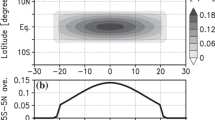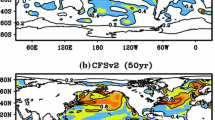Abstract.
The interannual variability associated with the El Niño/Southern Oscillation (ENSO) cycle is investigated using a relatively high-resolution (T42) coupled general circulation model (CGCM) of the atmosphere and ocean. Although the flux correction is restricted to annual means of heat and freshwater, the annual as well as the seasonal climate of the CGCM is in good agreement with that of the atmospheric model component forced with observed sea surface temperatures (SSTs). During a 100-year simulation of the present-day climate, the model is able to capture many features of the observed interannual SST variability in the tropical Pacific. This includes amplitude, lifetime and frequency of occurrence of El Niño events and also the phase locking of the SST anomalies to the annual cycle. Although the SST warming during the evolution of El Niños is too confined spatially, and the warming along the Peruvian coast is much too weak, the patterns and magnitudes of key atmospheric anomalies such as westerly wind stress and precipitation, and also their eastward migration from the western to the central equatorial Pacific is in accord with observations. There is also a qualitative agreement with the results obtained from the atmospheric model forced with observed SSTs from 1979 through 1994. The large-scale dynamic response during the mature phase of ENSO (December through February) is characterized by an eastward displacement and weakening of the Walker cell in the Pacific while the Hadley cell intensifies and moves equatorward. Similar to the observations, there is a positive correlation between tropical Pacific SST and the winter circulation in the North Pacific. The deepening of the Aleutian low during the ENSO winters is well captured by the model as well as the cooling in the central North Pacific and the warming over Canada and Alaska. However, there are indications that the anomalies of both SST and atmospheric circulation are overemphasized in the North Pacific. Finally, there is evidence of a coherent downstream effect over the North Atlantic as indicated by negative correlations between the PNA index and the NAO index, for example. The weakening of the westerlies across the North Atlantic in ENSO winters which is related to a weakening and southwestward displacement of the Icelandic low, is in broad agreement with the observations, as well as the weak tendency for colder than normal winters in Europe.
Similar content being viewed by others
Author information
Authors and Affiliations
Additional information
Received: 31 October 1995 / Accepted: 29 May 1996
Rights and permissions
About this article
Cite this article
Roeckner, E., Oberhuber, J., Bacher, A. et al. ENSO variability and atmospheric response in a global coupled atmosphere-ocean GCM. Climate Dynamics 12, 737–754 (1996). https://doi.org/10.1007/s003820050140
Issue Date:
DOI: https://doi.org/10.1007/s003820050140




